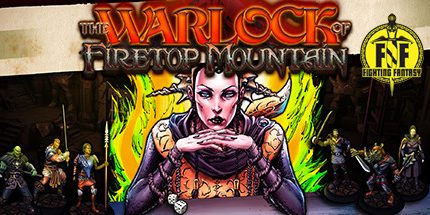In the 80s, while dice-and-paper D&D based RPGs were slowly being introduced to a bigger audience, teenagers who didn’t have friends to play with found companionship in gamebooks. Among the first examples of these RPG influenced Choose Your Own Adventure experience, was the classic Fighting Fantasy series was The Warlock of Firetop Mountain, originally written by RPG veterans Ian Livingstone and Steve Jackson. It is the gamebook most people remember when thinking back to those carefree days spent hunched on a book, trying to find dices to roll, defeating monsters and trying to progress. Anyone nostalgic enough will be happy to know that the video game version feels exactly like going back to those long afternoons leafing through battles and weird encounters, for better or worse.
Let’s turn the page and get adventuring.
Designed by Tin Man Games, a development team specialised in digital gamebooks, the title was released for most mobile platforms along with Windows. It is, then, of no surprise that it is controlled exclusively via the mouse, featuring a pretty simplified interface. As one might expect from the references to the RPG books, the player chooses a predefined character and enters the titular mountain, having to battle fierce creatures and make choices at every turn.
Naturally each choice has consequences, even one as innocent as choosing between going west or east; it is interesting to note that each run is not randomly generated, hence as long as one remembers the right choices, the chances of succeeding should grow with each playthrough. Combat is, naturally, different from the books, those featured a simplified Dungeons & Dragons style combat with dice throwing. The videogame actually works similar to a digital Heroquest: the player is cast in a turn based battle in small rooms with a choice between attacking and moving.
To survive, it is essential to pay close attention and try to guess each enemy’s intentions, based on the enemy pieces shake and turn, even though they get more and more unpredictable the further the hero travels. The writing is well done, pretty on par with the quality standard one has come to expect from the Fighting Fantasy series. There have been some variations from the original book, but the writers had no intention of reinventing the wheel, instead sticking to what the series does best: weird encounters, some humour and light sarcasm here and there.
Permadeath is, naturally, still a thing but the player gets three resurrection stones and checkpoints in order to try again. Die three times and the game’s over. There aren’t that many unfair cheap deaths as I remembered from the ol’ days of adventuring, but there’s still quite a few of them, it is to be expected, after all, the original book is from 1982. The world was a crueler place back then. Or was it?
The graphics are nothing to write home about, it is to be expected from a title mainly aimed at mobile platforms. Still, they serve their purpose into bringing a Choose Your Own Adventure world to life. To balance the rather mundane 3D look, the game uses many of the original book drawings, with a rather nifty paintbucket effect to colour them in, which adds a bit more flair to the proceedings.
From a design standpoint, what fascinates me about The Warlock of Firetop Mountain is how it manages to provide the exact experience one might be expecting reading a description like “a RPG gamebook”. This is good news if, of course, one is looking to play a digital gamebook or just wants something different from the usual 3D RPGs, but, on the other hand – in both cases – some additional features would have gone a long way into making the whole experience feel a bit less repetitive.
For example, the possibility to play a randomly generated adventure with a personalized character would have gone a long way into making each playthrough feel a bit more unique. There is a bit of variety in the various forks in the road and choices the player can make but, naturally, everything starts to feel pretty samey after a couple of hours.
The Warlock of Firetop Mountain was developed with love and care, aimed to scratch a very specific itch: fans that have always wanted to see the original Fighting Fantasy book come to life and interact with it. Make no mistake, they will love it. Myself, I’m not exactly a fan of those old gamebooks, I have surely read and played my fair share of them, but I wouldn’t say it is an experience I’m looking forward to repeating. Still, I found myself fascinated by Tin Man Games’ reimagining. It may be lacking in modern RPG bells and whistles or mindblowing new features, but in its straightforwardness and throwback simple mechanisms, I felt very much at home.
I always commend every RPG that at least tries that do something different and well, to be honest, despite its simple design choices, The Warlock feels almost like it belongs in a genre of its own. For casual fans, I would recommend maybe looking into the mobile version so that they can play in short bursts on the go.
Thank you for reading.
If you would like to help me to keep the project running, be sure to check out my patreon or alternatively, offer me a coffee.





